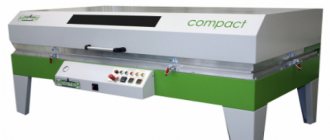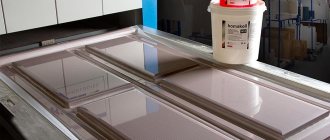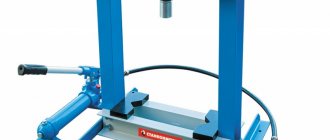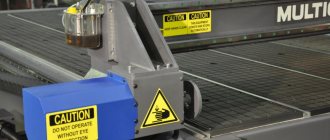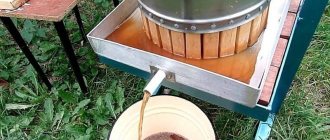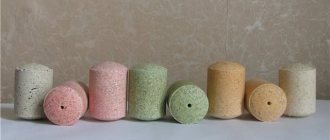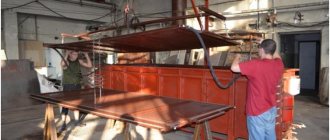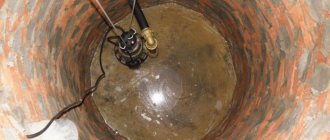What is a vacuum press for and how does it work?
Cabinet and upholstered furniture are often made from film furniture facades, since the latter combine such advantages as: • a wide range of colors; • various forms; • low cost.
To produce such facades, special equipment is used, and the main tool in this production is a vacuum press. The device allows you to shrink PVC film onto a workpiece with an MDF base.
The press consists of the following key elements:
• vacuum chamber or table; • thermal module.
The chamber is usually made in a rectangular shape, a rigid material is used for it - when negative pressure is artificially created from inside, this material does not compress. On the outside, PVC film is laid and its edges are sealed with the frame.
The film shrinks in the following order:
• the workpieces are placed on the table; • sealing process; • films heat up; • air is pumped out; • cooling process; • blanks are cut out, excess film is removed from the facade.
Purpose of vacuum and membrane presses
The main purpose of such presses is to cover MDF and chipboard panels with PVC film and natural veneer. Today, when such inexpensive panels lined with film and veneer are popular in the market, presses have become in-demand equipment, without which not a single woodworking and furniture production can do.
The use of such installations allows finishing:
- Cabinet furniture.
- Panel.
- Kitchen facades.
- Door panels.
- Various furniture products.
If in the past equipment was controlled exclusively by an operator and had a mechanical drive, today the most popular is fully automated equipment, which is controlled through preset programs.
How to make a vacuum table
Vacuum bath
A 2 mm steel sheet is used as the bottom of the vacuum bath. In order to minimize the deflections of the sheet, which will be affected by negative internal pressure, and to make the table surface as even as possible, we proceed to the manufacture of the stiffening frame. We make this design from the same profile pipe 60x40x2.
The pre-cut pipe, as indicated in the project, is laid on the slipway, rigidly secured with clamps, and all connections are welded. When the stiffening frame is ready, a sheet of steel is welded on top of it. At this most critical stage of welding work, a continuous sealed weld must be ensured. It is recommended to do it with double boiling.
To prevent the sheet from warping due to prolonged exposure to high temperature, you can use the following alternative method to weld the sheet to the frame. Before laying the steel sheet on the stiffening frame, we apply a sealing compound around the perimeter of the sheet, which is designed to withstand high temperatures. Here you can use, for example, silicone high-temperature sealant. Welding is not carried out in the form of a continuous seam, here we make regular fixing tacks - a step of approximately 50 mm.
This method ensures that due to short-term local effects of welding, the entire sealant will not be damaged or burned out, but only a small part directly at the tacks. For the most part, the sealant, after it hardens, will perform its function.
How to make a stiffening frame and assemble a vacuum bath:
• welding the stiffening frame; • weld a sheet of steel to it; • around the perimeter of the sheet we hermetically weld a stationary lower frame, which includes a part of the hinge joint that fixes the lifting upper frame.
Membrane vacuum press: types, principle of operation, DIY production
The furniture industry today is developing at a very active pace, which is associated with an increase in people's well-being and, accordingly, with an increase in demand for furniture that improves the quality of life and makes it more comfortable.
This, as well as the fact that modern consumers have become more demanding not only of the quality of furniture, but also of its decorative characteristics, has led to the fact that enterprises operating in this industry have become increasingly active in using innovative techniques and high-tech technologies in their production. equipment, one type of which is a vacuum press.
The vacuum press is used in the production of furniture facades, table tops, doors and for the production of decorative elements from acrylic or ABS plastic
The use of a vacuum machine and corresponding consumables makes it possible to provide furniture with completely unique decorative characteristics, which significantly increases the competitive advantages of the enterprise that uses this equipment in its production.
Operating principle
The main area of application of vacuum presses is the furniture industry, where such equipment is used in the production of elements of cabinet and upholstered furniture - for gluing elements of furniture structures with PVC film and veneer, which perform primarily decorative functions. The tasks of the vacuum press in this case include depositing the film or veneer and ensuring their tight fit to the surface of the furniture structural element.
The principle by which a vacuum press works for veneering and covering furniture blanks with PVC film is quite simple. The heated film, which has become more plastic under the influence of the vacuum created under its surface, tightly fits the furniture piece, accurately repeating its configuration.
The film applied using vacuum technology to the surface of a piece of furniture made from MDF or chipboard lasts a very long time and does not contain even the smallest air bubbles.
The process of gluing a furniture element with PVC film using a vacuum press includes such technological operations as:
- laying furniture pieces on the equipment table;
- covering the workpieces with film and installing a pressure frame;
- sealing the vacuum chamber;
- heating the chamber and pumping air out of it;
- cooling of workpieces already covered with film;
- cutting the film along the contour of the blanks.
Design features
The vacuum press for furniture facades and other elements of its design consists of the following elements:
- a vacuum table on the surface of which furniture pieces are laid (the surface of such a table must have high rigidity, so it is sheathed with sheet metal or thick tin);
- a vacuum pump, the task of which is to pump out air from under the surface of the film for furniture blanks;
- a clamping frame, which is also made of durable metal (the function of such a frame, equipped with reliable clamping elements, is to ensure the tightness of the air cavity under the film that covers the furniture blanks);
- heating installation, which can be made on the basis of working elements of various types;
- cover of a vacuum press, which can be hinged or roll-type.
Most models of vacuum presses are additionally equipped with one or more shafts installed at the end of the equipment. Such shafts, which make working on a vacuum press more convenient and reduce the time required to complete technological operations, are used to install rolls of film used for coating.
Many modern models of vacuum presses for MDF and chipboard can operate in automatic mode, which is ensured by CNC systems installed on such equipment.
The use of CNC vacuum presses is especially relevant for enterprises that produce furniture in series, when such equipment has to be used to cover many similar parts with film or veneer.
In such cases, CNC systems installed on such equipment make it possible to increase its productivity and, accordingly, reduce the cost of manufactured products. Industrial CNC membrane vacuum press with heated top and bottom platen
Main varieties
Today, two types of vacuum presses are produced:
- conventional type equipment (such presses are used in cases where it is necessary to exert the most gentle influence on the workpiece, and are capable of creating a pressure whose value does not exceed 0.95 kg/cm2);
- high-pressure vacuum presses (equipment of this type is capable of providing pressure up to 8.5 kg/cm2).
Equipment of the first type is used in cases where it is necessary to cover products with a simple configuration with PVC film or veneer.
Vacuum presses capable of creating high pressure are used for veneering or covering with PVC film parts of complex shapes.
In addition, such equipment is often used as a vacuum molder, with the help of which three-dimensional products of various configurations are made from sheet plastic.
The most common two layout options for vacuum presses are:
Purpose of the membrane in the design of a vacuum press
Both types of devices are equipped with a special membrane, so their more correct name is membrane-vacuum presses. Such an element of a vacuum press is used both when veneering elements of furniture structures and when covering them with PVC film.
In the first case, the membrane is necessary in order to increase the pressure exerted on the surface of the workpiece and the coating material during the process of joining them. In addition, when creating a veneer layer on the surface of a workpiece made of MDF or chipboard, the membrane prevents the coating material from shifting relative to the surface of the workpiece during the process of joining them.
When covering furniture pieces with too thin PVC films, the membrane protects them from the negative effects of high temperatures created in a vacuum chamber.
The membranes that vacuum presses are equipped with can be of two types: rubber and made of silicone. A more preferable option is silicone membranes, since they are more wear-resistant and allow you to cover even very small parts with PVC film.
Other Applications
In addition to gluing the surface of furniture structural elements with veneer and PVC film, a membrane vacuum press (MVP) can be successfully used to solve other problems, which, in particular, include:
- transfer of inscriptions and images to any surface using sublimation;
- formation of volumetric parts for various purposes from plastic sheets.
To transfer images from special paper to almost any (including embossed) surfaces using the sublimation method, equipment such as a thermal vacuum press is used.
Using a thermal vacuum membrane press, you can apply inscriptions and images to products made from ceramics, plastic, textiles and other materials. The principle on which a membrane vacuum heat press works is as follows.
- The product with a sheet of paper attached to it, from which an inscription or image needs to be transferred, is placed on the table of a vacuum press.
- The tight pressure of a sheet of paper with an image or inscription on the product is ensured by the press membrane, under which a vacuum is created.
- Under the press lid, after it is closed, a temperature is created, under the influence of which the image or inscription from the paper is transferred to the surface of the product.
Vacuum heat presses, presented on the modern market with a wide variety of models, are actively used by both large printing enterprises and small companies engaged in the production of souvenirs.
A vacuum molding press is used to produce relief-shaped products from sheet plastic.
How to make a lifting, pressing, top frame
We use a 60x40x2 mm profile pipe as the frame material. The clamping frame is made exactly in the same dimensions as the vacuum frame. If it was not possible to get an even profile - not bent or twisted, then we select the straightest sheets in pairs. From these we will make parts of the vacuum table that fit tightly together.
The lifting of the clamping frame will be carried out through adjustable hinge joints. The hinges can be adjusted when a seal is glued in the form of strips of sheet rubber with medium hardness - approximately 2 mm thick.
Welded washers are required to increase the friction area. The hinge pin is in the form of a steel rod D12, the ends of which have threads.
To keep the pressure frame raised, we can use gas elevators.
Application
When making furniture, parts made from particle boards, for example MDF, are covered with PVC film. It is also used to cover door trims.
Such cladding has an attractive appearance at a low cost. But covering wood with film is not at all as simple a task as, for example, gluing wallpaper. A special device called a vacuum press is required.
This machine consists of the following components:
- The bed is the base on which all the elements are assembled.
- Vacuum chamber. A durable box with an open top into which the workpieces are placed. Then it is covered with PVC film.
- A heating element (thermal module), through which the film is heated to the required temperature.
- Vacuum system – pump with additional equipment. These components are designed to pump air out of the vacuum chamber.
- A cabinet in which the electrical circuit of the machine is assembled.
When the air is pumped out, the heated film fits around the parts coated with glue in a vacuum chamber, after which the coating can only be dried and trimmed here and there.
Tools
The basic set of tools is the same as for the manufacture of any other products from a steel profile:
- inverter-type welding machine with a welding current of up to 130 A;
- electrodes with a diameter of 2 – 2.5 mm;
- grinder with a working part diameter of 150 mm and a cutting wheel for it;
- electric drill with metal drills with a diameter of 10 mm and a metal brush;
- metal scribe;
- metal scissors;
- exhaust riveter;
- roulette.
You will also need a set of wrenches.
Bed:
- steel rectangular pipe 60x40x2 mm;
- the same with a section of 20x20x2 mm;
- bolts M10x60, M10x80, M10x140 with nuts and washers.
Vacuum chamber:
- steel pipe 60x40x2 mm;
- steel sheet S – 2 mm;
- rubber tape for seal;
- a stud with a diameter of 12 mm and 2 nuts for it;
- pipe DN50;
- rod with a diameter of 10 mm;
- steel pipe 20x20x2 mm.
Vacuum system:
- vacuum water ring pump VVN 1-1.5-5.5;
- vacuum gauge;
- steel sheet S = 2 mm;
- ball valve for hot water;
- vacuum hose with a diameter of 50 mm.
Thermal module:
- pipe with a cross section of 20x20 and 60x40 mm;
- ball bearings type 6200;
- steel sheet S = 0.5 mm;
- aluminum rivets;
- glass with tinting film;
- aluminum foil S = 0.1 mm;
- lamp KGT 220-1000-6 (22 pcs.).
Construction drawing
This version of a homemade vacuum press is supposed to be equipped with a recoil-type thermal module (see diagram below).
Other types of heaters - lifting and swing - are more difficult to manufacture and less convenient to use. The thermal module is equipped with rollers (ball bearings) and moves on rails (20x20 pipe). There is a parking space for it on the frame.
The dimensions chosen for the vacuum chamber are 2.5 x 1.4 m. This length is optimal for the manufacture of the most typical furniture facades, and the width corresponds to the most common type of PVC film.
It is intended to load parts with a thickness of no more than 32 mm into the chamber, so its height, taking into account the thickness of the linings, air-permeable platform and seals, is taken to be 60 mm (made from a pipe 60x40x2 mm).
The machine is configured in such a way that the clamping frame, when folded, rests on the parked heater, so no additional devices are required to keep it in the raised state. The frame tilts back thanks to a hinge (works similar to a door hinge).
Work order
The manufacture of a vacuum press is carried out as follows:
bed
The frame parts must be welded according to the drawing. Next, the seams are cleaned, the necessary holes are drilled, the rust is removed with a wire brush and the entire structure is primed for subsequent painting.
Vacuum chamber
A stiffening frame should be welded from a 60x40 pipe, which will hold the bottom of the chamber (steel sheet 2 mm thick) from bending under the influence of atmospheric pressure.
Next, the bottom is welded to the frame, and the walls of the chamber are welded on top of it (a 60x40 pipe placed on the narrow side). Welds inside the chamber must be sealed (double penetration is recommended). A part of the hinge with two eyes must be welded to one of the walls.
The clamping frame is made from the same profile and has the same dimensions as the vacuum chamber. The second part of the hinge is welded to it.
To tightly compress the film with a clamping frame, eccentric clamps are used, which are made from a DN50 pipe, a rod with a diameter of 10 mm and a square pipe 20x20 mm.
If during the manufacture of the chamber its bottom has sagged, it can be filled with a self-leveling mixture (for example, based on epoxy resin) used for the manufacture of self-leveling floors.
The finished camera must be secured with 4 bolts on special frame supports. Next, you should install the eccentric clamps, assemble the clamping frame hinge and stick the seal.
Inside the chamber, over its entire area, an MDF platform is installed, consisting of 9 perforated rectangles with grooves cut on their surface (MDF sheet thickness is 10 mm).
The parts to be processed will be placed on it. Thanks to this platform, air will be pumped out throughout the entire volume of the chamber evenly, regardless of the position of the parts being processed and the film.
Vacuum system
To pump air out of the vacuum chamber, it is recommended to equip the press with a liquid ring type pump (model VVN1-1.5-5.5). A check valve and a vacuum gauge must be embedded in the pipeline connecting the pump to the vacuum chamber. For reliability, you can also install a shut-off valve.
To operate the pump, you need clean water, free from mechanical impurities, for storage of which a steel tank with a volume of about 30 liters should be provided (you can weld it yourself from a steel sheet).
The pump must be installed in a strictly horizontal position (controlled by level) on a concrete base, and screwed with anchor bolts. In this case, it is necessary to build walls around the unit or place it in a recess, since water will flow out of it during operation.
Water is supplied from the tank to the pump and returned through two hoses, which must withstand temperatures of up to 100 degrees.
All threaded connections in the vacuum pipeline must be sealed with FUM tape or similar material. To connect the pipeline to the vacuum chamber, a pipe is cut into the latter. It should be below the breathable platform and located in the middle of one of the walls. The pipeline is connected to the pump via a flange.
After assembling the machine, the vacuum system must be checked. The inlet of the vacuum pipeline inside the chamber is blocked with a piece of plywood, after which the pump is started. After 5 seconds, the vacuum gauge should show at least -0.85 atm.
Thermal module
The thermal module frame is welded from a 20x20 pipe and is equipped with handles, as well as supports for attaching wheel axles (60x40 pipe). The function of the wheels will be performed by type 6200 bearings. The frame casing is made of steel sheet 0.5 mm thick with aluminum rivets.
Viewing windows measuring 40x20 cm should be cut in the side walls and tinted glass should be installed in them.
Also, holes with a diameter of 50 mm with shutters must be drilled in the walls, through which it will be possible to measure the temperature of the film using a pyrometer.
Height-adjustable suspensions for KGT (quartz halogen thermal) lamps should be made from threaded rods, with insulating fiberglass plates with dimensions 40x20x2 mm secured to their ends.
The pins are screwed into holes drilled in the thermal module cover. The lamps themselves are screwed to fiberglass plates with M5x20 bolts using Grover washers.
Power supply for the lamps (they are divided into several groups) is provided by RKGM wire in a heat-resistant sheath with TML type tips. Several wires from different groups are powered from a common bus in the distribution box, to which the power cable is supplied.
After manufacturing, the thermal module should be installed on rails welded to the frame.
Clamps
To hold the film securely and airtight when vacuum pressing occurs, we press the top frame tightly and evenly against the perimeter of the vacuum frame. This way the rubber seal will fit completely.
Homemade clamps, which operate on the eccentric principle, are made from the following rolled steel:
• 1 pipe DN50: 0.5 m, with an outer diameter of approximately 60 mm; • rod: 2 m, diameter 10 mm; • profile pipe: 2 m, 20x20x2 mm.
We adjust the clamps by installing combination nuts in the desired location on the stud thread and securing them with locknuts. This operation is performed at the final stage of manufacturing the vacuum table, after the rubber seal has been glued.
Do-it-yourself veneering
Veneering of a wooden base is also called veneering. Veneering, as strictly speaking, veneering, involves gluing thin plates of wood, veneer, onto a wooden base. The basis is tables, doors, cabinets, walls and other wooden surfaces. We will tell you in more detail about what types of veneering exist, why to do it and how to do it yourself, in the article.
Why is furniture veneered?
Veneer is a thin sheet of wood, usually of valuable species. Veneer is used to make an ordinary, inexpensive tree, in all external appearances, a valuable, expensive species.
As a result, the price of veneered furniture is several times lower than that of solid wood of valuable species. And the appearance is practically in no way inferior to the second.
In addition to cost benefits, the use of veneer provides ample design opportunities. You can also paste over old furniture with it, thereby breathing a second life into it.
DIY veneering process
As we said earlier, the most affordable method for home use is hot veneering. To work you will need the following basic materials and tools from the list:
- Veneering base
- Wood veneer
- Plywood knife
- PVA glue
- Blank sheet of paper
- Roller or wooden block for grouting veneer
- Sandpaper
- Iron, the heavier the better
- Cutter
Preparatory work
Before you start veneering, you need to first prepare the veneer. Veneer is of natural origin, often rolled into rolls. The veneer may also be warped and so on.
To give the veneer the correct position, moisten it with damp water, a sponge, and place it between two sheets of plywood. To remove excess moisture, place wrapping paper between the plywood and the veneer, on both sides of the veneer.
Most often, planed veneer is used for finishing furniture. These are narrow but long sheets. The width of sliced veneer, as a rule, is no wider than 30 centimeters.
Therefore, after leveling and removing excess moisture from the surface of the veneer, we cut the sheets to the required length. If, for example, you want to cover a table, then the veneer should protrude slightly from the edges of the base. The excess, at the end of the veneering process, can be cut off or sanded.
By the way, do not cut the veneer with a knife or scissors. Veneer can crack and is cut unevenly with these devices. Use a plywood knife or planer to cut veneer.
Gluing veneer and base
Apply PVA glue to the veneer and base. Coat the base area with the base. It is best to coat it with glue twice. Dry the first layer of glue until it is almost completely dry, so that the glue practically stops sticking. Dry the second layer until it is tack-free.
The next step is to heat the iron to 50 degrees. This is approximately the average temperature for the iron. And iron the veneer through a sheet of white paper. After passing the iron, we immediately begin to rub in the veneer and base with a roller or block.
It is necessary that the veneer sheets overlap by 3-4 mm. When gluing the joints, pay special attention. As if press it with an iron.
Next, check if there are any voids left between the veneer and the base. To do this, lightly tap your nails on the veneer. If voids are found, smooth them again with an iron. If the air does not escape, then we make a small cut, with a thin sharp edge, on the veneer. And fill the swelling with glue using a syringe.
Shutdown
After the glue has completely dried, trim and sand the excess veneer. Be careful when sanding. Veneer is a very thin material. It can be easily wiped clean. And all your work will be ruined.
After sanding is completed, we cover the product with stain, varnish and perform the final finishing.
Device
Photo of a vacuum press
A vacuum press consists of several main elements:
- Frame. Often this supporting structure is made in a collapsible type, which allows for repair, maintenance, disassembly for convenient transportation;
- Desktop. This is also a supporting structure, which is equipped with a special clamping frame;
- Vacuum system. This pneumatic system is the main element, without which it is difficult to imagine a vacuum press as such;
- Retractable carriage. There is a heating element here that is powered by electricity;
- Automatic control. Press vacuum drying chambers, doors, carriages, and the vacuum system itself operate using automatic controls. The operator's participation is minimal, which makes it possible to achieve higher quality artificial veneering, manufacturing elements for furniture facades, gluing plastic, chipboard, MDF, etc.
Photo of a vacuum press device, to create with your own hands
Vacuum press is classified according to several main characteristics. Let's start with the automation level. Depending on this characteristic, devices for pressing wood, facades, plastic, artificial stone are divided into two types.
- Automatic. Here, the wood, artificial stone, and plastic presser performs all operations independently, so operator participation is practically not required.
- Semi-automatic. These are more outdated models of wood pressing machines, since the operator must open the doors of the press chamber, press buttons to start, turn off, and remove compressed elements from wood, plastic, and MDF with his own hands. Their life is gradually coming to an end, since it is more efficient to work with devices where the mold operates in an accelerated automatic mode.
DIY vacuum press for MDF facades
Production of bent MDF facades on a thermo-vacuum press with a membrane
The first stage of the process of bending a workpiece in a press is to install a matrix of a suitable size on its working table. The matrix is the lower part of the equipment, which is used in the manufacture of furniture facades. It is selected by size depending on the required radius of the facade. In this case, the height of the sash and the length of the chord can vary - the main thing is that the chord of the matrix exceeds the chord length of the largest product with which you have to work.
Press or bag
Before you buy an ST 420 press or make a vacuum press with your own hands instead of an ST 420, you should learn about such a thing as a bag press.
- The press bag is designed so that you can make a vacuum press with your own hands;
- Its essence lies in the fact that the bag itself represents a press machine;
- A product made of wood, chipboard, MDF, prepared for gluing, is placed in the bag;
- The bag is sealed on all sides, which allows for sealing;
- Using a pump, air is pumped out of the bag, which allows you to gradually create the necessary pressure, evenly distributed over the workpiece being processed;
- Next, the bag stands in a compressed state for some time, after which the workpiece is removed;
- The main advantage is that the cost of the bag is tens of times less than the price of the machine. A press measuring 1400 by 2500 mm will cost the buyer $1,000, while a bag can be purchased for 500-1,000 rubles. You don’t need any drawings to make an effective press from a bag yourself to create elements of facades, furniture, etc. We draw conclusions and make a decision.
But the bag cannot be compared with the ST 420 machine. The modern ST 420 device has unique properties, since we are talking about a 3D press machine. The ST 420 model can be used for private businesses when applying images to T-shirts, mugs, and to create cases for tablets and smartphones. At the same time, ST 420 costs about 70 thousand rubles.
The bag is certainly not capable of what the ST 420 can produce. But the choice is yours.
Self-production of a vacuum press
Modern vacuum membrane presses are very easy to use. They can be controlled by easy-to-use digital programmable touch screen controls. User-defined program memory and control via vacuum parameters of pressure, time and/or temperature enable fully automatic production. Process control guarantees a high level of quality.
Many craftsmen are guided by the desire to minimize costs and wonder whether it is possible to make a press with their own hands. A DIY vacuum press is easy. On the Internet you can find drawings of the device and buy the necessary components. If you approach everything wisely, then making it yourself will cost much less than buying serial equipment. Before manufacturing the press, it is necessary to carefully study the design, find the optimal technical parameters and buy components with consumables. You also need to have an electric drill, a welding machine, an angle grinder and a set of plumbing tools.
Source: lesoteka.com
Recommendations for selection
When choosing a membrane press for the manufacture of facades from MDF, chipboard, furniture elements, pay attention to several issues.
- Pump. The membrane press can be equipped with our or a foreign pump. Italian models are a priority. Although they are more expensive, they are more effective, reliable and durable.
- Table material. It is best if the desktop is made of metal. A number of machine models are made of chipboard, but they quickly become unusable and the surface is damaged during production.
- Machine dimensions. The main characteristic on which the ability to create parts of certain dimensions depends.
- Heater. There are heating elements and KGT lamps. Choose the second type as they do not burn the film.
Don't forget about the manufacturer. Little-known companies should not be trusted. But it doesn’t always make sense to overpay for a brand.
